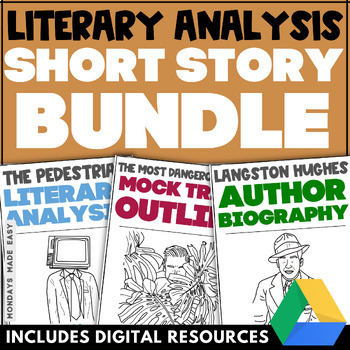Short Story Bundle - Literary Analysis Activities for Secondary - Digital, Print
- Zip
- Google Apps™

What educators are saying
Products in this Bundle (47)
showing 1-5 of 47 products
Bonus
Description
This short story bundle features literary analysis worksheets and activities for classic short stories that students love! Enhance your narrative reading unit with these anchor charts, graphic organizers, pre-reading activities, comprehension questions, vocabulary worksheets, and assessments! Suitable for online learning and Google Classroom®.
⚡️⚡️⚡️ Save over 50% with the bundled discount! ⚡️⚡️⚡️
Short stories included with this bundle:
1. “The Lottery” by Shirley Jackson
Examine conformity, superstition, and blind tradition in Shirley Jackson's "The Lottery" using this dystopian short story bundle! This engaging unit teaches students how to make predictions and how to write a comparison paragraph; it also explores literary devices including imagery, mood, and symbolism. Students will also read about global traditions with the real-life parallels examined in this unit!
2. “The Yellow Wallpaper” by Charlotte Perkins Gilman
Perfect for Women’s History Month! This bundle for Charlotte Perkins Gilman's "The Yellow Wallpaper" examines women's health, subordination in marriage, and the culture of domesticity. Students will also explore literary devices like personification, euphemism, irony, and extended metaphor as they explore the riveting characterization within this short story.
3. “Lamb to the Slaughter” by Roald Dahl
A classic thriller and a student favorite! This short story unit for Roald Dahl’s "Lamb to the Slaughter" teaches reading strategies including making inferences and differentiating between direct and indirect characterization. Students will also learn about dramatic irony, puns, foreshadowing, and the different types of irony.
4. "Eleven" by Sandra Cisneros
Explore authority, identity, and obedience in this classic coming-of-age story! Students will examine perspective, point-of-view, and reliable narration in Sandra Cisneros' "Eleven." This short story unit also teaches about literary devices including symbolism and anaphora.
5. "The Cask of Amontillado" by Edgar Allen Poe
This spooky short story unit for Edgar Allen Poe’s “The Cask of Amontillado” explores revenge, betrayal, addiction, and justice. Students will analyze literary elements including setting and mood, and learn about literary devices like hyperbole, aphorism, and verbal irony. Students will also have fun exploring true crimes while learning how to write an argumentative paragraph.
Celebrate Indigenous resilience and examine the policing of First Nations peoples in Thomas King's short story, "Borders." This unit explores linear and non-linear plot structures to teach students about plot diagrams. Students are also introduced to the Five Questions Model (W5-H) and will practice writing expository news articles.
A wonderful short story to explore during the holiday season! This unit for Amy Tan’s “Fish Cheeks” examines cultural identity, shame, and religious norms. It explores narrative elements including literary conflict, imagery, and metaphor. Students will also learn about descriptive writing and learn how to write a narrative paragraph.
8. "The Necklace" by Guy de Maupassant
Examine artifice, envy, materialism, and honesty in this unit for Guy de Maupassant’s short story, “The Necklace.” Students will dive deep into characterization as they learn about character types and character roles, and examine literary elements including situational irony, juxtaposition, and character foil.
9. “Thank You, Ma’am” by Langston Hughes
The perfect literary pairing for both Valentine's Day and Black History Month! Explore compassion, generosity, dignity, and shame with this unit for Langston Hughes’ short story, “Thank You, Ma’am.” Students will identify tone, analyze themes, and make text-to-text connections with three famous poems by Langston Hughes.
10. "The Pedestrian" by Ray Bradbury
Deep dive into the negative consequences of technology with this dystopian short story! Ray Bradbury's "The Pedestrian" is a futuristic and arguable prophetic look at a world where people choose screen time over human interaction. Students will study Bradbury's brilliant use of simile and metaphor in this story. They will also learn about expository writing and the writing process in order to write an information paragraph exploring the relevance of one overarching theme in the story.
11. "The Most Dangerous Game" by Richard Connell
This short story unit will have your students on the edge of their seats! Examine empathy, moral philosophy, and the impact of war using the resources provided. Students will learn about context, setting, pathetic fallacy, and characterization. They will also learn about the legal system and argumentative writing by conducting a mock trial of S. Rainsford v. The State of New York!
⭒ For classrooms utilizing Google Classroom® ⭒
To access the digital version of these resources, simply follow the instructions within the resource to copy the files directly to your Google Drive®.
✨ Kindly note that due to copyright restrictions, these resources are not editable unless otherwise noted. This is a common practice within the TPT marketplace in order to protect the clip artists and software providers that have authorized their intellectual property for the development of this resource.
You might also be interested in Mondays Made Easy's Literary Analysis Resources.
➖➖➖➖➖➖➖➖➖➖➖➖➖➖➖➖➖➖➖➖➖➖➖➖➖➖➖➖➖➖
⭐ Customer Tip! ⭐
Want FREE CREDIT to go towards purchases? Make sure to offer feedback for your downloads! Follow these instructions below:
- Go to your "My Purchases" page to find a "Provide Feedback" button next to each download.
- Follow this link to offer a quick rating and leave a short comment for the product. Each time you give feedback, TPT gives you feedback credits that you use to lower the cost of your future purchases!
- Your feedback is important to me as it helps me to continually improve my products and ensure they are meeting your needs!
Follow me! Be the first to know about product launches, sales, discounts, and free giveaways:
➾ The Blog
For questions, collaborations, or other concerns:
✉ Contact me: hello@mondaysmadeeasy.com
Access my Free Resource Library!
➖➖➖➖➖➖➖➖➖➖➖➖➖➖➖➖➖➖➖➖➖➖➖➖➖➖➖➖➖➖
Mondays Made Easy is committed to the continual improvement of resources to meet the current needs of teachers. This product was last updated on May 3, 2023.





